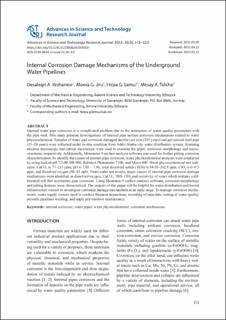| dc.contributor.author | Yeshanew, Desalegn A. | |
| dc.contributor.author | Jiru, Moera G. | |
| dc.contributor.author | Lemu, Hirpa Gelgele | |
| dc.contributor.author | Tolcha, Mesay A. | |
| dc.date.accessioned | 2023-03-21T09:49:57Z | |
| dc.date.available | 2023-03-21T09:49:57Z | |
| dc.date.created | 2022-08-17T14:20:12Z | |
| dc.date.issued | 2022 | |
| dc.identifier.citation | Yeshanew, D. A., Jiru, M. G., Lemu, H. G., & Tolcha, M. A. (2022). Internal Corrosion Damage Mechanisms of the Underground Water Pipelines. Advances in Science and Technology Research Journal, 16(3), 111-123. | en_US |
| dc.identifier.issn | 2299-8624 | |
| dc.identifier.uri | https://hdl.handle.net/11250/3059465 | |
| dc.description.abstract | Internal water pipe corrosion is a complicated problem due to the interaction of water quality parameters with pipe wall. This study presents investigations of internal pipe surface corrosion mechanisms related to water physicochemical. Samples of water and corrosion-damaged ductile cast iron (30+ years) and galvanized steel pipe (15-20 years) were collected at in-situ condition from Addis Ababa city water distribution system. Scanning electron microscopy and optical microscopy were used to examine the pipes' corrosion morphology and microstructures, respectively. Additionally, Mountains 9 surface analysis software was used for further pitting corrosion characterization.To identify the causes of internal pipe corrosion, water physicochemical analyses were conducted by using inoLab pH 7310P, DR 900, Palintest Photometer 7100, and Miero 800. Water physicochemical test indicates: CaCO3 is 77 - 215 ppm, pH is 7.05 – 7.86, total dissolved solids (TDS) is 84.10 -262.8 ppm, ClO2 is 0 – 0.5 ppm, and dissolved oxygen (80-81 ppb). From water test results, major causes of internal pipe corrosion damage mechanisms were identified as dissolved oxygen, CaCO3, TDS, ClO2,and resistivity of water which initiates a differential cell that accelerates pipe corrosion. Using Mountain 9 surface analysis software, corrosion morphology and pitting features were characterized. The outputs of this paper will be helpful for water distribution and buried infrastructure owners to investigate corrosion damage mechanisms at early stage. To manage corrosion mechanisms, water supply owners need to conduct frequent inspections, recording of pipe data, testing of water quality, periodic pipelines washing, and apply preventative maintenance. | en_US |
| dc.language.iso | eng | en_US |
| dc.publisher | Lublin University of Technology | en_US |
| dc.rights | Navngivelse 4.0 Internasjonal | * |
| dc.rights.uri | http://creativecommons.org/licenses/by/4.0/deed.no | * |
| dc.title | Internal Corrosion Damage Mechanisms of the Underground Water Pipelines | en_US |
| dc.type | Peer reviewed | en_US |
| dc.type | Journal article | en_US |
| dc.description.version | publishedVersion | en_US |
| dc.rights.holder | the authors | en_US |
| dc.subject.nsi | VDP::Teknologi: 500::Materialteknologi: 520 | en_US |
| dc.source.pagenumber | 111-123 | en_US |
| dc.source.volume | 16 | en_US |
| dc.source.journal | Advances in Science and Technology Research Journal | en_US |
| dc.source.issue | 3 | en_US |
| dc.identifier.doi | 10.12913/22998624/149369 | |
| dc.identifier.cristin | 2043868 | |
| cristin.ispublished | true | |
| cristin.fulltext | original | |
| cristin.qualitycode | 1 | |

